 | TODAY IN SCIENCE HISTORY
NEWSLETTER - 1 FEBRUARY |
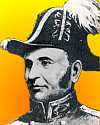 On 1 Feb 1836, John By died, an English military engineer who constructed the 126-mile (202-km) Rideau Canal connecting the Ottawa River and Lake Ontario, Canada. For centuries, navigable rivers provided a means of transportation and travel, long before railways and motorways. As the continent of North America was being populated by Europeans, they developed new infrastructure, and brought their knowledge of building additional artificial waterways—canals—to improve the transportation network beyond natural routes. The entry on John By in the Dictionary of National Biography (1901) shows he had to magae a tense relationship between the necessities of his work, and the funding of the unavoidable costs by parliamentary votes thousands of miles away. For his great achievement, he was ultimately unappreciated. On 1 Feb 1836, John By died, an English military engineer who constructed the 126-mile (202-km) Rideau Canal connecting the Ottawa River and Lake Ontario, Canada. For centuries, navigable rivers provided a means of transportation and travel, long before railways and motorways. As the continent of North America was being populated by Europeans, they developed new infrastructure, and brought their knowledge of building additional artificial waterways—canals—to improve the transportation network beyond natural routes. The entry on John By in the Dictionary of National Biography (1901) shows he had to magae a tense relationship between the necessities of his work, and the funding of the unavoidable costs by parliamentary votes thousands of miles away. For his great achievement, he was ultimately unappreciated. |
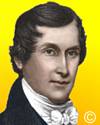 On 1 Feb 1820, a U.S. patent for a cement that hardened under water was issued to Canvass White, an engineer building the Erie Canal. Good stone locks required hydraulic cement as a water-proof mortar joints. At the time, all hydraulic cement was made in Europe and much too costly to import. It was part of his larger task of building a canal that would be a tremendous asset for transportation as the United States built new infrastructure for the emerging new nation. He lived a short, but productive life, as described in the Obituary for Canvass White in The History of Cohoes, N.Y. (1877) On 1 Feb 1820, a U.S. patent for a cement that hardened under water was issued to Canvass White, an engineer building the Erie Canal. Good stone locks required hydraulic cement as a water-proof mortar joints. At the time, all hydraulic cement was made in Europe and much too costly to import. It was part of his larger task of building a canal that would be a tremendous asset for transportation as the United States built new infrastructure for the emerging new nation. He lived a short, but productive life, as described in the Obituary for Canvass White in The History of Cohoes, N.Y. (1877) |
 On 1 Feb 1905, Emilio Segrè was born, Italian-American Nobel prize-winning physicist. Today's Science Store pick is: A Mind Always in Motion: The Autobiography of Emilio Segre, by Emilio Segrè, a personal account of his fascinating life as well as candid portraits of some of this century's most important scientists, such as Enrico Fermi, E. O. Lawrence, and Robert Oppenheimer. Segrè writes movingly of the personal devastation wrought by the Nazis, his struggles with fellow scientists, and his love of nature. His book offers an intimate glimpse into a bygone era as well as a unique perspective on some of the most important scientific developments of this century. It is available New from $37.20. Used from $5.94. (As of time of writing.). On 1 Feb 1905, Emilio Segrè was born, Italian-American Nobel prize-winning physicist. Today's Science Store pick is: A Mind Always in Motion: The Autobiography of Emilio Segre, by Emilio Segrè, a personal account of his fascinating life as well as candid portraits of some of this century's most important scientists, such as Enrico Fermi, E. O. Lawrence, and Robert Oppenheimer. Segrè writes movingly of the personal devastation wrought by the Nazis, his struggles with fellow scientists, and his love of nature. His book offers an intimate glimpse into a bygone era as well as a unique perspective on some of the most important scientific developments of this century. It is available New from $37.20. Used from $5.94. (As of time of writing.). | | For picks from earlier newsletters, see the Today in Science History Science Store home page. | |
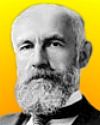 | Constant muscular activity was natural for the child, and, therefore, the immense effort of the drillmaster teachers to make children sit still was harmful and useless. - G. Stanley Hall, American psychologist (born 1 Feb 1844).  |
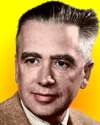 | The most striking impression was that of an overwhelming bright light. I had seen under similar conditions the explosion of a large amount—100 tons—of normal explosives in the April test, and I was flabbergasted by the new spectacle. We saw the whole sky flash with unbelievable brightness in spite of the very dark glasses we wore. Our eyes were accommodated to darkness, and thus even if the sudden light had been only normal daylight it would have appeared to us much brighter than usual, but we know from measurements that the flash of the bomb was many times brighter than the sun. In a fraction of a second, at our distance, one received enough light to produce a sunburn. I was near Fermi at the time of the explosion, but I do not remember what we said, if anything. I believe that for a moment I thought the explosion might set fire to the atmosphere and thus finish the earth, even though I knew that this was not possible. - Emilio Segr�, Italian-American physicist (born 1 Feb 1905).  |
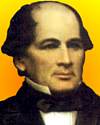 | It is a custom often practiced by seafaring people to throw a bottle overboard, with a paper, stating the time and place at which it is done. In the absence of other information as to currents, that afforded by these mute little navigators is of great value. - Matthew Fontaine Maury, American naval officer, oceanographer and hydrographer (died 1 Feb 1873).  |
| Before you look at today's web page, see if you can answer some of these questions about the events that happened on this day. Some of the names are very familiar. Others will likely stump you. Tickle your curiosity with these questions, then check your answers on today's web page. |
 | Emilio Gino Segr�, born 1 Feb 1905, was an Italian-born American physicist who was co-winner, with Owen Chamberlain of the United States, of the Nobel Prize for Physics in 1959 for the discovery of a certain particle. He also created atoms of the man-made new element technetium (1937) and astatine (1940).
 Which particle did he discover? |
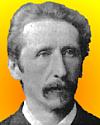 | Eduard Strasburger, born 1 Feb 1844, was a German plant cytologist who elucidated the process of nuclear division in the plant kingdom. He showed that the sperm and the egg have half the number of chromosomes found in body cells, and coined terms for the fluids found in a cell and its nucleus.
 What are the terms he coined for a fluid found in a cell and its nucleus? |
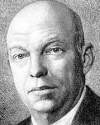 | Edwin H. Armstrong (1890-1954) was an American inventor who had been fascinated by radio from childhood. He invented the continuous-wave transmitter (1912), the regenerative circuit (1912), superheterodyne circuits (1918) and in 1933 a major invention that remains the backbone of modern radio communication as we know it. Exhausted by nonstop patent battles he died by suicide at night. (The time was unknown, so the date of death differs in sources, being given as either 31 Jan or 1 Feb.)
 What is the familiar name for his major invention for radio? |
 | A German physicist (1901-1976) who formulated quantum mechanics in terms of matrices was awarded the Nobel Prize for Physics for 1932. In 1927 he published his indeterminacy, or uncertainty, principle, for which he is best known.
 Can you name this physicist? |
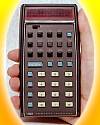 | On 1 Feb 1972, the first scientific hand-held calculator was releaseded in the U.S. by by Hewlett-Packard. The red LED display could give scientific notation up to 10 digits mantissa and 2 digits exponent. With 35 keys, it was called the HP-35, and its introductory price was set at $395.
 What would $395 be worth (40 years later) in 2012 dollars? |
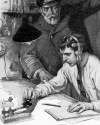 | On 1 Feb 1904, the first international radio distress signal became effective. It was established on 7 Jan 1904 by the Marconi Company. It was replaced by “SOS” effective in Jul 1908.
 What was this first international radio distress call? |
When you have your answers ready to all the questions above, you'll find all the information to check them, and more, on the February 1 web page of Today in Science History. Or, try this link first for just the brief answers.
Fast answers for the previous newsletter for January 31: gamma rays (of unvarying wavelength and frequency despite the recoil nucleus) • decade including the year 1907 • a small opening at the top of the canopy to improve air flow. • Saturn • Explorer I • chimpazee. |
 If you enjoy this newsletter, the website, or wish to offer encouragement or ideas, please send feedback by using your mail reader Reply button. If you enjoy this newsletter, the website, or wish to offer encouragement or ideas, please send feedback by using your mail reader Reply button.
Your click on a StumbleUpon, Google+ or Facebook social button on the site webpages is also a welcome sign of appreciation. Thank you for using them. |
To find citations for quotations go to the corresponding webpage by clicking on the “quotes” balloon icon. Sources for the thumbnails appear on today's webpage with the corresponding item.
� This newsletter is copyright 2014 by todayinsci.com. Please respect the Webmaster's wishes and do not put copies online of the Newsletter � or any Today in Science History webpage. (If you already have done so, please remove them. Thank you.) Offline use in education is encouraged such as a printout on a bulletin board, or projected for classroom viewing. Online, descriptive links to our pages are welcomed, as these will provide a reader with the most recent revisions, additions and/or corrections of a webpage. For any other copyright questions, please contact the Webmaster by using your mail reader Reply button. |
--
If you do not want to receive any more newsletters,
Unsubscribe To update your preferences and to unsubscribe visit
this link 


 On 1 Feb 1836, John By died, an English military engineer who constructed the 126-mile (202-km) Rideau Canal connecting the Ottawa River and Lake Ontario, Canada. For centuries, navigable rivers provided a means of transportation and travel, long before railways and motorways. As the continent of North America was being populated by Europeans, they developed new infrastructure, and brought their knowledge of building additional artificial waterways—canals—to improve the transportation network beyond natural routes. The entry on John By in the Dictionary of National Biography (1901) shows he had to magae a tense relationship between the necessities of his work, and the funding of the unavoidable costs by parliamentary votes thousands of miles away. For his great achievement, he was ultimately unappreciated.
On 1 Feb 1836, John By died, an English military engineer who constructed the 126-mile (202-km) Rideau Canal connecting the Ottawa River and Lake Ontario, Canada. For centuries, navigable rivers provided a means of transportation and travel, long before railways and motorways. As the continent of North America was being populated by Europeans, they developed new infrastructure, and brought their knowledge of building additional artificial waterways—canals—to improve the transportation network beyond natural routes. The entry on John By in the Dictionary of National Biography (1901) shows he had to magae a tense relationship between the necessities of his work, and the funding of the unavoidable costs by parliamentary votes thousands of miles away. For his great achievement, he was ultimately unappreciated.  On 1 Feb 1820, a U.S. patent for a cement that hardened under water was issued to Canvass White, an engineer building the Erie Canal. Good stone locks required hydraulic cement as a water-proof mortar joints. At the time, all hydraulic cement was made in Europe and much too costly to import. It was part of his larger task of building a canal that would be a tremendous asset for transportation as the United States built new infrastructure for the emerging new nation. He lived a short, but productive life, as described in the Obituary for Canvass White in The History of Cohoes, N.Y. (1877)
On 1 Feb 1820, a U.S. patent for a cement that hardened under water was issued to Canvass White, an engineer building the Erie Canal. Good stone locks required hydraulic cement as a water-proof mortar joints. At the time, all hydraulic cement was made in Europe and much too costly to import. It was part of his larger task of building a canal that would be a tremendous asset for transportation as the United States built new infrastructure for the emerging new nation. He lived a short, but productive life, as described in the Obituary for Canvass White in The History of Cohoes, N.Y. (1877) 



 Which particle did he discover?
Which particle did he discover? 
 What are the terms he coined for a fluid found in a cell and its nucleus?
What are the terms he coined for a fluid found in a cell and its nucleus? 
 What is the familiar name for his major invention for radio?
What is the familiar name for his major invention for radio? 
 Can you name this physicist?
Can you name this physicist? 
 What would $395 be worth (40 years later) in 2012 dollars?
What would $395 be worth (40 years later) in 2012 dollars? 
 What was this first international radio distress call?
What was this first international radio distress call?  If you enjoy this newsletter, the website, or wish to offer encouragement or ideas, please send feedback by using your mail reader Reply button.
If you enjoy this newsletter, the website, or wish to offer encouragement or ideas, please send feedback by using your mail reader Reply button. 

Δεν υπάρχουν σχόλια:
Δημοσίευση σχολίου